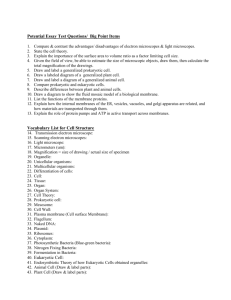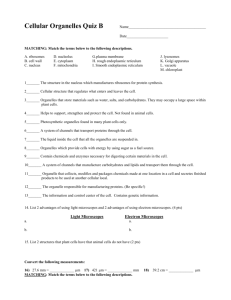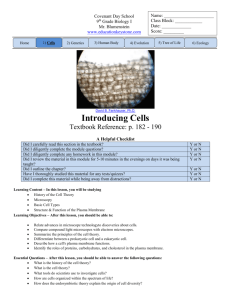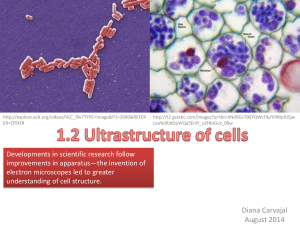1.2 Ultrastructure of cells assessment
advertisement
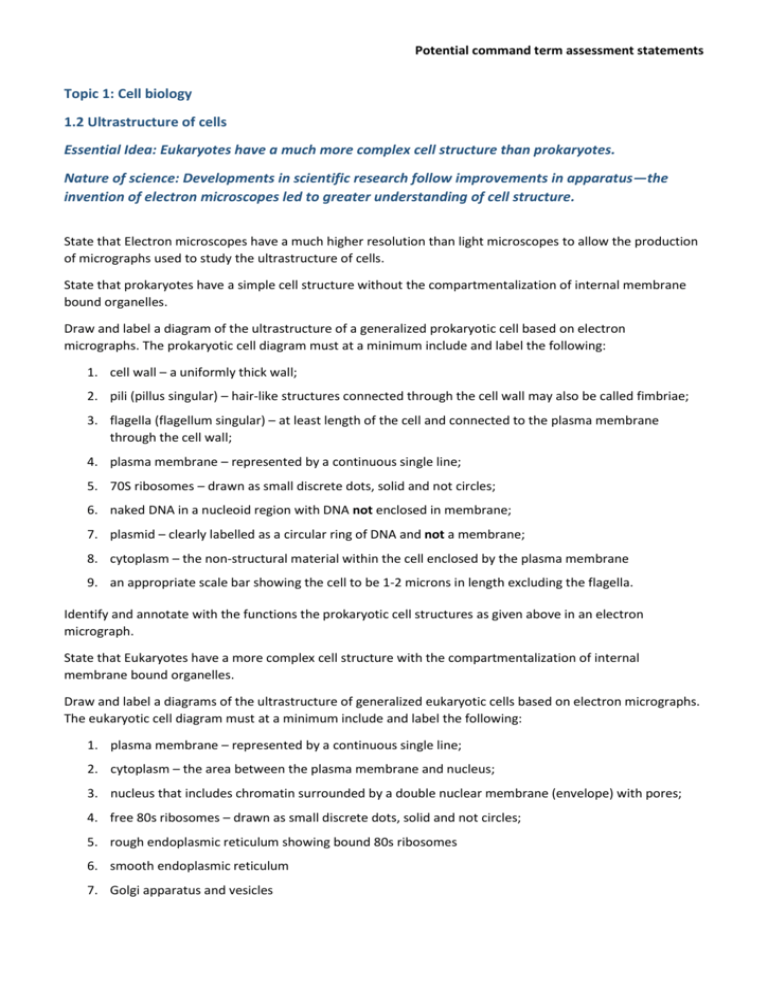
Potential command term assessment statements Topic 1: Cell biology 1.2 Ultrastructure of cells Essential Idea: Eukaryotes have a much more complex cell structure than prokaryotes. Nature of science: Developments in scientific research follow improvements in apparatus—the invention of electron microscopes led to greater understanding of cell structure. State that Electron microscopes have a much higher resolution than light microscopes to allow the production of micrographs used to study the ultrastructure of cells. State that prokaryotes have a simple cell structure without the compartmentalization of internal membrane bound organelles. Draw and label a diagram of the ultrastructure of a generalized prokaryotic cell based on electron micrographs. The prokaryotic cell diagram must at a minimum include and label the following: 1. cell wall – a uniformly thick wall; 2. pili (pillus singular) – hair-like structures connected through the cell wall may also be called fimbriae; 3. flagella (flagellum singular) – at least length of the cell and connected to the plasma membrane through the cell wall; 4. plasma membrane – represented by a continuous single line; 5. 70S ribosomes – drawn as small discrete dots, solid and not circles; 6. naked DNA in a nucleoid region with DNA not enclosed in membrane; 7. plasmid – clearly labelled as a circular ring of DNA and not a membrane; 8. cytoplasm – the non-structural material within the cell enclosed by the plasma membrane 9. an appropriate scale bar showing the cell to be 1-2 microns in length excluding the flagella. Identify and annotate with the functions the prokaryotic cell structures as given above in an electron micrograph. State that Eukaryotes have a more complex cell structure with the compartmentalization of internal membrane bound organelles. Draw and label a diagrams of the ultrastructure of generalized eukaryotic cells based on electron micrographs. The eukaryotic cell diagram must at a minimum include and label the following: 1. plasma membrane – represented by a continuous single line; 2. cytoplasm – the area between the plasma membrane and nucleus; 3. nucleus that includes chromatin surrounded by a double nuclear membrane (envelope) with pores; 4. free 80s ribosomes – drawn as small discrete dots, solid and not circles; 5. rough endoplasmic reticulum showing bound 80s ribosomes 6. smooth endoplasmic reticulum 7. Golgi apparatus and vesicles Potential command term assessment statements 8. lysosome 9. mitochondrion (mitochondria plural) shown with a double membrane, cristae and matrix; 10. centrosome made up of centrioles; 11. eukaryotic cells of plants and fungi also have a cell wall. State at least three differences between the structures of animal cells and plant cells (must include cell walls, chloroplasts and a large central vacuole for maintaining turgor pressure). Annotate electron micrographs of exocrine gland cells of the pancreas and palisade mesophyll cells of a leaf to show the structure and function of the eukaryote organelles listed above. General Instructions for drawings in Biology: Draw simple 2D diagrams. Diagrams needs to be made with clean smooth pencil lines without shading. The relative sizes and shapes of all structures must be correct. Labels lines should be made neatly with a ruler and accurately connect to the structure being labelled. Do not cross labeling lines. A scale bar to show the relative sizes must also be included with correct units. International-mindedness: Microscopes were invented simultaneously in different parts of the world at a time when information travelled slowly. Modern-day communications have allowed for improvements in the ability to collaborate, enriching scientific endeavor. Theory of Knowledge: The world that we inhabit is limited by the world that we see. Is there any distinction to be drawn between knowledge claims dependent upon observations made by sense perception and knowledge claims dependent upon observations assisted by technology?
